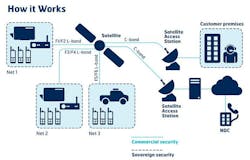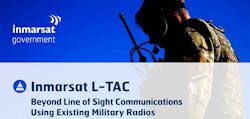Inmarsat’s L-TAC provides beyond-line-of-sight satellite communications to U.S. government users
WASHINGTON, 10 Oct. 2014. Inmarsat, a provider of global mobile satellite communication (SATCOM) services, is harnessing the skills of its partners and the capabilities of its Inmarsat-4 satellite constellation to expand the availability of mobile tactical beyond-line-of-sight (BLOS) communications to actively deployed U.S. and coalition forces.
The company’s L-band Tactical Satellite (L-TAC) service delivers a resilient Ultra High Frequency (UHF)-like tactical satellite capability to existing military and commercial radios used by the U.S. government, officials say. L-TAC uses the spectrum resources of the Inmarsat-4 constellation to augment UHF capacity on military satellites. It enables interoperable SATCOM using existing radios, waveforms, and cryptography.
L-TAC adds much needed channels where UHF SATCOM is restricted, degraded, or unavailable; it also can be used with very small antennas. This allows the service to support secure BLOS Push-to-Talk voice and data networks for both encrypted and non-encrypted terminals, whether man-portable or installed in vehicles, helicopters, ships, or other mobile platforms.
To access the L-TAC service, users require an easy-to-install antenna adaptor for existing tactical radios. With the addition of this applique, no additional training, certification, or infrastructure is needed. The L-TAC antenna is significantly smaller than most UHF SATCOM antennae, providing the added benefit of a lower-profile terminal. This interoperable augmentation capability allows tactical users to meet security and reliability requirements affordably and cost-effectively through L-band spectrum leases for durations as short as one month.
“In today’s unpredictable global environment, L-TAC expands mission-critical channels of communication for U.S. military and government personnel no matter where the mission takes them,” says Peter Hadinger, president of Inmarsat’s U.S. Government Business Unit. “This service was designed from the ground up to meet the government end users’ ever growing needs for Beyond Line-of-Sight connectivity in today’s congested tactical spectrum environment.”
In addition to the U.S. military and defense agencies, L-TAC will also support the civil government market for activities such as emergency response and border protection. By enabling interoperability between UHF and VHF radios on the same network, federal agencies, National Guard units and civilian personnel will be able to coordinate more effectively in the event of a major incident or civil emergency. This capability can create major savings for government by instantly lighting up nationwide mutual aid networks – covering large areas cost-effectively with existing equipment, while permitting extended reach for new public safety networks now in design.
“The positive feedback we’ve received from government users operating in the continental U.S. as well as in Europe, Africa, and the Middle East, has been tremendous. They’ve found L-TAC to be even more useful than anticipated, providing assured access to channels and facilitating the mobility that is critical to the success of their mission,” Hadinger concludes.
Inmarsat plc is a provider of global mobile satellite communications services. Since 1979, Inmarsat has been providing reliable voice and high-speed data communications to governments, enterprises, and other organizations, with a range of services that can be used on land, at sea or in the air. Inmarsat employs around 1,600 staff in more than 60 locations around the world, with a presence in the major ports and centers of commerce on every continent, officials say.



